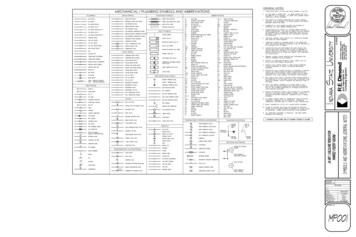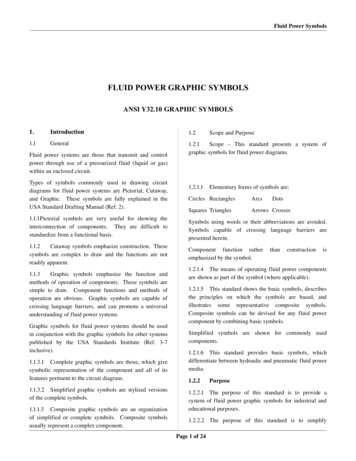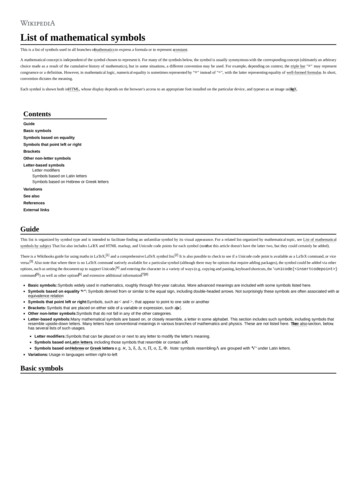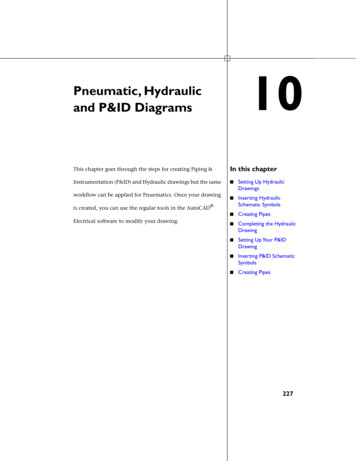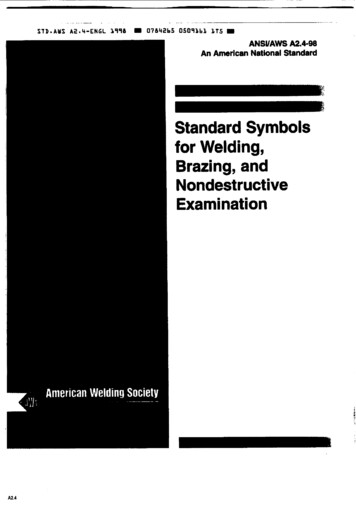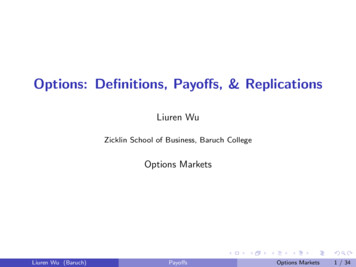
Transcription
Intrinsic Representation: Bootstrapping SymbolsFrom ExperiencebyStephen David LarsonSubmitted to the Department of Electrical Engineering and ComputerSciencein partial fulfillment of the requirements for the degree ofMaster of Engineering in Electrical Engineering and Computer Scienceat theMASSACHUSETTS INSTITUTE OF TECHNOLOGYSeptember 2003Copyright 2003 Stephen David Larson. All rights reserved.The author hereby grants to M.I.T. permission to reproduce anddistribute publicly paper and electronic copies of this thesis and togrant others the right to do so.Author . . . . . . . . . . . . . . . . . . . . . . . . . . . . . . . . . . . . . . . . . . . . . . . . . . . . . . . . . . . . . .Department of Electrical Engineering and Computer ScienceAugust 22, 2003Certified by . . . . . . . . . . . . . . . . . . . . . . . . . . . . . . . . . . . . . . . . . . . . . . . . . . . . . . . . . .Patrick H. WinstonFord Professor of Artificial Intelligence and Computer ScienceThesis SupervisorAccepted by . . . . . . . . . . . . . . . . . . . . . . . . . . . . . . . . . . . . . . . . . . . . . . . . . . . . . . . . .Arthur C. SmithChairman, Department Committee on Graduate Students
2
Intrinsic Representation: Bootstrapping Symbols FromExperiencebyStephen David LarsonSubmitted to the Department of Electrical Engineering and Computer Scienceon August 22, 2003, in partial fulfillment of therequirements for the degree ofMaster of Engineering in Electrical Engineering and Computer ScienceAbstractIf we are to understand human-level intelligence, we need to understand how meaningscan be learned without explicit instruction. I take a step toward that understandingby focusing on the symbol-grounding problem, showing how symbols can emerge froma system that looks for regularity in the experiences of its visual and proprioceptivesensory systems. More specifically, my implemented system builds descriptions upfrom low-level perceptual information and, without supervision, discovers regularitiesin that information. Then, my system, with supervision, associates the regularitywith symbolic tags. Experiments conducted with the implementation shows that itsuccessfully learns symbols corresponding to blocks in a simple 2D blocks world, andlearns to associate the position of its eye with the position of its arm.In the course of this work, I take a new perspective on how to design knowledgerepresentations, one that grapples with the internal semantics of systems, and I propose a model of an adaptive knowledge representation scheme that is intrinsic to themodel and not parasitic on meanings captured in some external system, such as thehead of a human investigator.Thesis Supervisor: Patrick H. WinstonTitle: Ford Professor of Artificial Intelligence and Computer Science3
4
AcknowledgmentsAbove all, I owe this to my thesis advisor and mentor, Patrick Winston, for givingme the right conceptual tools and biases and allowing me the freedom to ride out towhere only fools may tread.I owe the idea of an interactive space, in addition to several other technical innovations of my system, to several insightful conversations with Karl Magdsick.I owe significant conceptual clarity to Greg Detre, who has been extremely insightful in his comments on my drafts and has helped to make sure my argumentshold up to scrutiny.I owe many ounces of clarity in my thesis to several insightful conversations withRaj Krishnan, Dr. Kimberle Koile, and Keith Bonawitz. Their comments on text Ihad written or ideas in my head were very helpful.I owe my involvement in Artificial Intelligence to Jake Beal and Justin Schmidt.The former, who brought me on board the Genesis Project after being his student in6.034 and helped guide me to my thesis topic, and the latter, who I aspired to followas I watched him climb the ranks in this field.I owe much thanks to all the individuals who have participated in the GenesisProject research group in the years that I have been at MIT. Conversations from thisgroup have inspired me greatly.I owe thanks to the other superlative and inspiring professors of artificial intelligence that I have learned from while at MIT, namely Rodney Brooks, Marvin Minsky,and Randall Davis.And of course, I owe my ability to write this thesis at all to the love, nurturing,and respect of my parents, who have given me all the opportunities a human beingcould ask for.5
6
Contents1 Introduction171.1Preview . . . . . . . . . . . . . . . . . . . . . . . . . . . . . . . . . .191.2Overview . . . . . . . . . . . . . . . . . . . . . . . . . . . . . . . . . .192 Representation212.1The Symbol Grounding Problem . . . . . . . . . . . . . . . . . . . . .222.2Defining Representation . . . . . . . . . . . . . . . . . . . . . . . . .252.2.1The Meaning of Semantics . . . . . . . . . . . . . . . . . . . .262.2.2Internal Semantics . . . . . . . . . . . . . . . . . . . . . . . .272.2.3Interactive Spaces . . . . . . . . . . . . . . . . . . . . . . . . .292.2.4Implicit and Explicit Representation . . . . . . . . . . . . . .302.2.5Case Studies: Creatures and Neural Nets . . . . . . . . . . . .32Additional Desiderata . . . . . . . . . . . . . . . . . . . . . . . . . .342.3.1Semantic Completeness . . . . . . . . . . . . . . . . . . . . . .352.3.2Knowledge Generation . . . . . . . . . . . . . . . . . . . . . .362.33 Model of Intrinsic Representation373.1The Model . . . . . . . . . . . . . . . . . . . . . . . . . . . . . . . . .373.2Theoretical Foundation . . . . . . . . . . . . . . . . . . . . . . . . . .383.2.1Regularity in the Environment . . . . . . . . . . . . . . . . . .383.2.2Information Spaces . . . . . . . . . . . . . . . . . . . . . . . .403.2.3Implicit Representation . . . . . . . . . . . . . . . . . . . . . .41Key Points . . . . . . . . . . . . . . . . . . . . . . . . . . . . . . . . .413.37
4 Tools for Implementation4.14.24.34.443Self-Organizing Maps . . . . . . . . . . . . . . . . . . . . . . . . . . .434.1.1The Basic Algorithm . . . . . . . . . . . . . . . . . . . . . . .45Growing Self Organizing Maps . . . . . . . . . . . . . . . . . . . . . .464.2.1Map Growth. . . . . . . . . . . . . . . . . . . . . . . . . . .464.2.2Map Stopping Criterion . . . . . . . . . . . . . . . . . . . . .47Clustering . . . . . . . . . . . . . . . . . . . . . . . . . . . . . . . . .484.3.1The Basic Algorithm . . . . . . . . . . . . . . . . . . . . . . .49Cluster Association . . . . . . . . . . . . . . . . . . . . . . . . . . . .515 Architecture and Implementation5.153Architecture . . . . . . . . . . . . . . . . . . . . . . . . . . . . . . . .535.1.1Blocks World . . . . . . . . . . . . . . . . . . . . . . . . . . .535.1.2Blocks World to Self-Organizing Map . . . . . . . . . . . . . .565.1.3Self-Organizing Map to Cluster Set . . . . . . . . . . . . . . .575.1.4Cluster Set to Cluster Association . . . . . . . . . . . . . . . .575.1.5Modality A to Modality B . . . . . . . . . . . . . . . . . . . .595.2Three Levels of Representations . . . . . . . . . . . . . . . . . . . . .595.3Learning About Blocks . . . . . . . . . . . . . . . . . . . . . . . . . .625.3.1Training The Eye Map . . . . . . . . . . . . . . . . . . . . . .645.3.2Training The Arm Map. . . . . . . . . . . . . . . . . . . . .655.3.3Eye Map With Interactions . . . . . . . . . . . . . . . . . . .655.3.4Clusters . . . . . . . . . . . . . . . . . . . . . . . . . . . . . .705.3.5Associations . . . . . . . . . . . . . . . . . . . . . . . . . . . .70Associating Hand with Eye . . . . . . . . . . . . . . . . . . . . . . . .745.4.1Training . . . . . . . . . . . . . . . . . . . . . . . . . . . . . .745.4.2Clusters . . . . . . . . . . . . . . . . . . . . . . . . . . . . . .745.4.3Associations . . . . . . . . . . . . . . . . . . . . . . . . . . . .765.4.4Activity . . . . . . . . . . . . . . . . . . . . . . . . . . . . . .785.48
6 Discussion816.1Symbol Grounding and Intrinsic Representation . . . . . . . . . . . .826.2Semantic Completeness . . . . . . . . . . . . . . . . . . . . . . . . . .836.3Knowledge Generation . . . . . . . . . . . . . . . . . . . . . . . . . .837 Contributions85A Multidisciplinary Background87A.1 Computational Neuroscience . . . . . . . . . . . . . . . . . . . . . . .87A.2 Systems Neuroscience . . . . . . . . . . . . . . . . . . . . . . . . . . .89A.3 Machine Learning . . . . . . . . . . . . . . . . . . . . . . . . . . . . .91B Related Work939
10
List of Figures3-1 The model of intrinsic representation. Two information spaces, i andj, are shown side by side. At the bottom, information from the environment impinges on the most peripheral sensory neurons, creatingsignals in information spaces. Over time, the regularity in the information space is stored in a map by way of a process of self-organization.From this map, clusters of high similarity can be segmented and reifiedas their own units. Associations are created and strengthened based onthe co-activation between clusters in different information spaces, creating networks of activation. As members of these networks, clusterscan be used as inputs in new information spaces and can be associatedwith other co-occurring units in different systems, allowing reactivationof local clusters from afar. . . . . . . . . . . . . . . . . . . . . . . . .394-1 A self-organizing model set. An input message X is broadcast to aset of models Mi , of which Mc best matches X. All models that lie inthe vicinity of Mc (larger circle) improve their matching with X. Notethat Mc differs from one message to another. [from fig.1 in (Kohonenand Hari 1999)] . . . . . . . . . . . . . . . . . . . . . . . . . . . . . .454-2 The insertion of cells [from (Dittenbach, Merkl and Rauber 2000)] . .474-3 A cluster tree produced by UPGMA. Data points 1-5 are clustered.Clusters are indicated by crossbar junctions. The height of the crossbarcorresponds to the similarity level of the cluster. The clusters in thisdiagram are: (3 4), (1 5), (3 4 2), and (3 4 2 1 5) . . . . . . . . . . .1149
5-1 A simple 2D Blocks World. . . . . . . . . . . . . . . . . . . . . . . . .545-2 Blocks World to Self-Organizing Maps. Data from the blocks world isread out into a self-organizing map for each modality in the form ofreal-valued normalized vectors. . . . . . . . . . . . . . . . . . . . . . .575-3 Self-Organizing Map to Cluster Set. A map is divided up into clustersA, B, and C using a clustering algorithm that operates on its cells. . .585-4 Cluster Set to Cluster Association. Clusters in different maps are associated together. . . . . . . . . . . . . . . . . . . . . . . . . . . . . .5-5 An example of a trained representation.58Representation has beentrained with the eye fixated on the arm and no blocks. Arm and eyewere moved together throughout the space. Clusters were formed, andfurther arm-eye movement was used to create associations between theclusters. This shows how the arm can then move to a location the eyeis looking at by using the trained representation. . . . . . . . . . . . .605-6 Each SOM cell stores an n-dimensional vector that represents a pointin an n-dimensional information space. . . . . . . . . . . . . . . . . .615-7 A cluster in a SOM represents a collection of cells, which in turn represents a collection of points in an n-dimensional information space .625-8 A guide to the features stored in the visual and arm data vectors thatarrive at the eye map and the arm map respectively. The visual dataincludes x and y coordinates for the eye position, followed by r, g, and bwhich store the red, green and blue values for each pixel position in theeye. The arm data includes h, v, and g which store the horizontal andvertical components, the width of the grip, and 6 sensor values thatare read from sensors on the gripper/hand. All values are normalizedbetween 0.0 and 1.0. . . . . . . . . . . . . . . . . . . . . . . . . . . .635-9 My system upon start up. A simple 2D Blocks World and two GSOMsare visible. No training has occurred. . . . . . . . . . . . . . . . . . .1264
5-10 A visual representation of the eye map trained on white space just afterinitialization. Currently the eye map is only 2 by 2 but will grow asthe eye map trains. The top number in each cell is its quantizationerror, the middle number is the id of its cluster (currently -1 becauseno clustering has occurred yet), and the bottom numbers read out thevalues of the x and y features of the cells model vector. In the titlebar, the number preceding ”left” indicates l, how many units until themap stop criterion and the number to the right indicates the meanquantization error for the entire map. . . . . . . . . . . . . . . . . . .655-11 A visual representation of the arm map just after initialization. Currently the eye map is only 2 by 2 but will grow as the eye map trains.The top number in each cell is its quantization error, and the lowernumber is the id of its cluster (currently -1 because no clustering hasoccurred yet). Within each cell is a cartoon representing the arm. Eachsegment of the cartoon arm is colored from red to green based on thevalues of the underlying model vector. For example, a model vectorrepresenting the arm in the bottom right corner of the map would havea light green horizontal component and a light green vertical component. A model vector representing the arm in the upper left cornerwould have both components bright red. The gripper/hand part ofthe cartoon also changes colors related to its representations, rangingfrom green to red as it constricts. Underneath the gripper/hand aresix small rectangles that indicate the binary values of the sensors onthe arm, white for off, black for on. In the title bar, the number preceding ”left” indicates l, how many units until the map stop criterionand the number to the right indicates the mean quantization error forthe entire map. . . . . . . . . . . . . . . . . . . . . . . . . . . . . . .1366
5-12 A visual representation of the eye map partially trained on the fourobjects in the simple 2D blocks world. The map has now grown tobetter fit the data. In the bottom left, the map shows a few viewsof the blue block. In the bottom right several cells show views of thered block. In the upper right, middle and center, several views of thegripper/hand can be seen. The cells along the upper and middle leftshow views of the green block. The “smeared” cells are the productof different inputs that came soon after one another and thus createdcells that are on a cluster border. The title bar shows that there are10 units left until the map stop criterion. . . . . . . . . . . . . . . . .675-13 A trained arm map. A clear distinction between cells representing thehand while the middle sensors are active (when it is holding a block)and while they are not is seen from left to right. Within these twogroups, there is a relatively smooth distribution of arm location. . . .685-14 A trained eye map, complete with views of the arm interacting withblocks. . . . . . . . . . . . . . . . . . . . . . . . . . . . . . . . . .695-15 A trained eye map with clusters overlaid. The cluster IDs of relevantclusters are highlighted. . . . . . . . . . . . . . . . . . . . . . . . . .715-16 A trained arm map with clusters overlaid. The cluster IDs of relevantclusters are highlighted. . . . . . . . . . . . . . . . . . . . . . . . . .725-17 A trained eye map with clusters overlaid. Relevant clusters are highlighted. All the cells show closely similar views of the world, but the xand y components vary across the map. . . . . . . . . . . . . . . . . .755-18 A trained arm map with clusters overlaid. Relevant clusters are highlighted. While the gripper sensors and grasp remain constant, the mapself-organizes using the horizontal and vertical components of the dataalone. . . . . . . . . . . . . . . . . . . . . . . . . . . . . . . . . . . .76A-1 The Perception-Action cycle. Modified from (Fuster 2003). . . . . . .9014
List of Tables5.1The major associations between symbols and clusters in the eye map735.2The major associations between symbols and clusters in the arm map735.3Associations between the eye map and the arm map. . . . . . . . . .7715
PrefaceI believe that the major hurdles in the path of achieving human-level artificial intelligence are conceptual rather than technical. I share the concern among someresearchers that the pathway to achieving such a goal is still, after fifty years of AIresearch, hazy at best.I feel that AI has an excellent opportunity to integrate knowledge from other brainsciences because of its emphasis on modeling theories with computers. Unfortunately,it is difficult to gather enough multi-disciplinary knowledge and instinct to be fluent inthe languages of the other relevant sciences. Nevertheless, AI should reach out to theseoutside influences and use them to further restrict its design space. It needs to increaseits focus on systems that are biologically inspired and neurologically plausible. Itneeds to focus on representations that brains make.With this in mind, the hope of this thesis is to remove some of the obstacles alongthe pathways of integration between the brain sciences.“Do not go where the path may lead. Instead go where there is no pathand leave a trail.” – Gandhi16
Chapter 1IntroductionImagine that it is the year 2053 and you are standing in front of a humanoid robotempowered with human-level artificial intelligence. This robot is lying on the floor infront of you, fresh out of the box. It has never been used. As you turn it on, you aresurprised by the behavior that ensues. Rather than leaping up and doing intelligentthings, the robot begins twitching on the floor. Its limbs jolt around randomly, andits eyes roam wildly. Believing that your product is defective, you take a moment toperuse the included instruction guide. You are once again surprised upon learningthat this behavior is the normal start up process for the robot.After a few minutes, the robot’s motions become less erratic. Its eyes begin tofocus on things in the world, and soon can keep its gaze fixed on objects as it moves.Its limbs, weak at first, begin experimenting with some toy objects included in thepackage. The robot picks them up and watches them fall.As you continue to watch the robot, you observe it rapidly developing skills in thesame way that human children develop them, only much faster. It begins walkingaround on unsteady legs, gradually gaining a confident walk. It inevitably makes somemistakes during this process, but learns as much from its mistakes as its successes.After a few hours, your robot begins prompting you to speak to it. After a few morehours of conversation, the robot is as capable with language as a 10-year old. It hasessentially “grown up” before your eyes.After observing this miracle, you begin to research the advances in the last fifty17
years of artificial intelligence that have enabled robots to have this kind of intelligence,and in particular why this kind of training process is necessary. You discover thatsoon after the turn of the century, AI research experienced a paradigm shift. In itsearly years, the field made a lot of advances solving hard problems using relativelysimple representational schemes for storing information about the world. Only a fewdecades later, however, AI had run up against a wall in its attempts to create systemsthat could solve a broader class of problems. The old representational schemes wereunable to draw much relevant information from the real world by themselves, insteadrelying mostly on human hand-coding of information to make sense of the world.The representational schemes that ushered in the new age of AI focused less oninformation bundled into discrete elements. Instead, they focused on how informationcan be flexibly, quickly, and continuously collected from the world and how it can beprofitably utilized to solve problems. Researchers discovered that by coordinatingthe learning processes of multiple sensory devices, their systems were able to learnabout a lot of important relationships in the world. By organizing simple learnedrelationships in a powerful way, these systems were able to build new descriptionsfrom old descriptions the way a human does. The units of representation, or symbols,that were generated had intrinsic meaning by virtue of the fact that they were createdby a scheme already familiar to the system. Strangely, the designers themselves werenot always able to fully interpret the descriptions of the world that their systemscame to use internally, as they were grounded in complex nonlinear systems. Thishowever, did not prevent them from being built, as the designers understood theprinciples that enabled the descriptions to be to be created and utilized effectively.More than anything, it was a complete understanding of these principles that enabledthe creation of human-level artificial intelligence systems.“Aha,” you say to yourself, “this explains the learning processes I observed withthe robot. It didn’t come pre-packaged with all the data it needed to know, it wasallowed to learn and build knowledge as it interacted with the world, the way humansdo. It reminds me of the old parable, give a man a fish, he eats for a day, teach aman to fish, he eats for a lifetime.”18
1.1PreviewThe story in the previous section is a fanciful fictional account, but it outlines myvision of the end of a long journey for which this thesis is an early step. While we arestill a long way off from building the kind of robot described above, I have designedand implemented a computer program that demonstrates some of the properties ofthe idealized system described above. Its key features are: Collects information from its environment quickly and flexibly in a way thatcan be used to solve problems. Discovers and organizes simple relationships in the information that it collects. Uses the results of its organizing process to bootstrap higher-level descriptions,such as symbols. Grounds the meaning of the descriptions it discovers in a semantics definedentirely by the system itself, thus creating intrinsic representation.The system demonstrates these features by way of two experiments. In the firstexperiment the system learns symbols corresponding to blocks in a simple blocksworld. In the second, the system learns to associate the position of its eye with theposition of its arm.1.2OverviewIn chapter 2, I give more specifics about the limitations of modern representations.I use the symbol grounding problem as a motivating problem, discuss the nature ofrepresentation, and introduce the ideas of semantic completeness and knowledge generation. I turn to a more detailed explanation of the model of intrinsic representationin chapter 3. In chapter 4, I describe the significant components of my implementation. In Chapter 5, I tie the elements introduced in chapter 4 together and explain19
the architecture and implementation of my model. In chapter 6, I analyze the implications of my work in light of the issues brought up earlier. In chapter 7, I summarizethe contributions I have made.Many influences prompted me to write this thesis. In part, I was influenced by abroad set of readings across several different fields. To provide a sense of these fields,I have provided a multi-disciplinary review in Appendix A. Additionally, I compareand contrast other work similar in spirit to my thesis, by, for example, Agre andChapman, Drescher, and Roy, in Appendix B.20
Chapter 2Representation“Once a problem is described using an appropriate representation, theproblem is almost solved.” (Winston 1993)How the brain represents the building blocks of thought is one of the remainingunsolved mysteries of human existence. That the brain creates representations ofsome kind is clear; we observe many organisms acting on prior information. Suchbehavior necessitates that organisms appropriately store and retrieve information. Inhumans, these representations are well suited to enable the performance of an endlessnumber of tasks. What is less clear is how the brain represents this information insuch an advantageous way.Because computer models are dynamic and can be updated quickly and on demand, sophisticated computer models have been made possible. Today, computersare used for modeling a variety of complicated things car engines, economic theories,and the human genome are just a few. Our understanding of the representations usedin the building of models has improved in proportion to our understanding of how tobuild models at all. What we have discovered is that within narrow, well-defined problem domains, finding the right representations is a matter of reductionism. Withinthese domains, good representations are found first by understanding the basic principles of the desired application, and then by matching an appropriate encoding scheme.However, in problem domains where the basic principles are unclear, finding good rep21
resentations is much more difficult. How the brain builds representations that enableit to carry out tasks for survival is currently one of those uncharted domains. Unfortunately, our ability to make some powerful representations has not yet translated toan ability to make the kind of powerful representations the brain can.2.1The Symbol Grounding ProblemOne of the drawbacks of traditional symbolic AI reasoning systems is their domainspecificity. What causes this? Harnad, with his description of the symbol groundingproblem, sheds some light on this question. He describes the problem as the following:“How can the semantic interpretation of a formal symbol system be madeintrinsic to the system, rather than just parasitic on the meanings in ourheads?” (Harnad 1990)A symbol is merely a label for a larger body of knowledge that is difficult todescribe without that label. Harnad says that the label should at no point be confusedfor the larger body of knowledge to which it refers.An example of this problem is seen by considering a person reading the word“chair.” This action summons a mental image of the object. However, the perceptionof the printed word by itself is not equivalent to the perception of the mental image.One can think at length about a chair beyond the five letters of its English representation. One can consider its various aspects, chairs that one is familiar with, andso on. Those abilities must be fueled by information that is obviously not containedin the letters C-H-A-I-R. The letters are more like a trigger. Our extensive abilityto recall information about a chair makes it clear that there is more to our mentalrepresentations of words than their printed image.For a symbolic system, however, the printed image is almost exclusively whatrepresents an object. To date, symbolic systems lack the ability to intrinsically interpret the meaning of data that is intended to represent a chair. For example, some ofthe most common symbolic representations of traditional AI are semantic nets and22
frames. These representations describe a data object as a collection of other dataobjects that model its different properties. For example, a chair may be a memberof the category of ‘furniture’ and may have the texture of ‘wooden’. However, theseassociated properties of a chair are merely other symbols; other labels that humansgive meaning to.This limitation does not prevent us from creating systems that function withcompetency at specific tasks such as playing chess. This is because within the domainof chess, we are able to define all the relevant information about the symbols. Thelegal moves of a chess piece are easy to program and do not ever vary. However,when we attempt to create systems to operate outside of a limited domain, theirfunctionality is limited by the information that can be given to it, as well as the waythat information can be stored.The symbol grounding problem challenges us to distinguish between two separateconcepts. On the one hand, we have a symbol as analogous to markings on a piece ofpaper. On the other hand we have the mental processes that allow us to consider asymbol’s meaning. It also forces us to consider that our brains store more informationabout things in our world than we are able to describe.For example, when we look at a toy block, we have a wealth of information aboutit at our fingertips. We can produce language concerning the block; we can say itsname, its color, its shape, or describe its purpose. We also can solve problems withit, such as figuring out if it would fit inside a particular box, or if it could be usedto hold up other blocks. We know what it feels like to pick it up, and we know whathappens if we balance it on its corner.As you read the previous paragraph, you recall these different aspects of a block foryourself. By invoking the symbol “block”, you have triggered your personal knowledgeabout a physical object. Is the description in your brain equivalent to the descriptiongiven above? Are there really English sentences stored in your brain that tell youwhat a block feels like in words? Or is it possible that it is represented in a separateway that enables a description in language? Most likely we do not use only verbaldescriptions of things to store information about familiar objects, but rather, verbal23
descriptions provide a convenient way of aggregating that information.As a solution to the symbol grounding problem, Harnad proposes to under-girdthe computer descriptions of symbols with non-symbolic representations derived fromsensory experience. Such non-symbolic representations are real-valued, and are derived from the information received from our most peripheral neurons. The meaningof symbols can be defined as the recollection of experiences associated with them ifsensory experience is used as the greatest common denominator representation. Forexample, a toy block can be represented as the combination of all of the sensory andmotor interactions that one has had with a toy block.Cl
successfully learns symbols corresponding to blocks in a simple 2D blocks world, and learns to associate the position of its eye with the position of its arm. In the course of this work, I take a new perspective on how to design knowledge representations, one that gr

